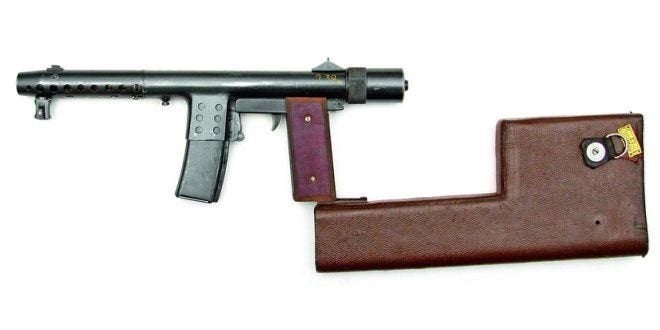A little over six months ago we published an article about an independent Soviet firearms designer named Firs Barkanov and his firearm designs. Today we will tell about another such arms designer – Foma Yazikov. This exclusive content was published by the Kalashnikov Guns Magazine. Mikhail Degtyaryov, the chief editor of the KGM, kindly gave us permission to use the content.
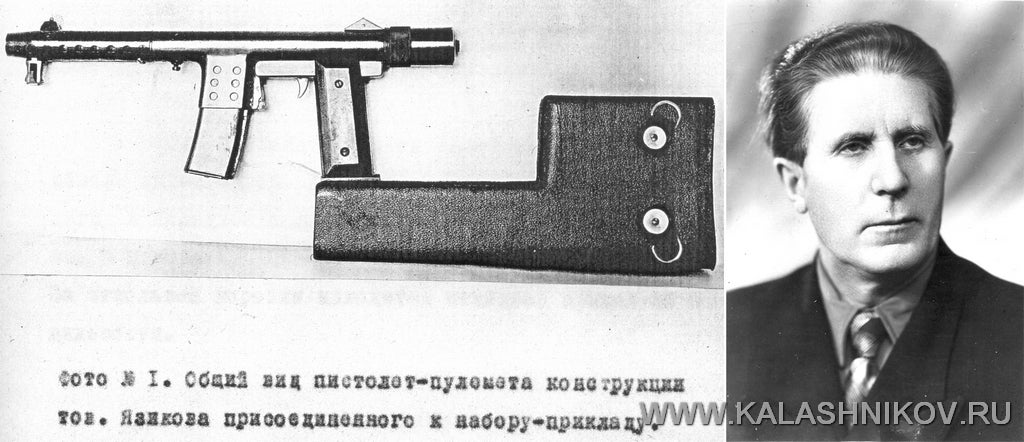
Photos of Foma Yazikov’s and his SMG’s from the test report
As I mentioned in the Barkanov article, not only these firearms themselves are interesting but also the fact that the designers managed to get permission from the Soviet government to independently design firearms. I think it is safe to say that in most cases getting such permission was something close to impossible. The way that firearms were designed in the Soviet Union was quite different. The only places where firearms were developed were the government armories and design bureaus and designing guns independently was uncommon, to say the least. In the case of Yazikov, probably what made the government allow him design firearms was that it was a wartime (WW2) and any possible invention that could improve the firepower and efficiency of troops was probably given a chance.
One of the Yazikov’s firearms that still exists is a submachine gun. Below we’ll take a look at the features of this SMG and after that, we’ll see what information we have concerning other firearms designed by Yazikov.
Yazikov SMG (KPPYa)
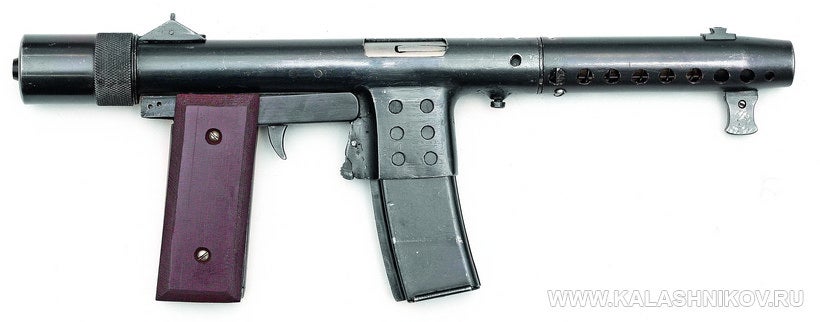
Yazikov was not only a firearms designer but an inventor in general. Before the war, he has been working on designing mechanisms for motorcycles and vehicles. Once the war broke out, just like many others, Yazikov also joined the army. He first started thinking about designing his own submachine gun in 1943. As Yazikov himself describes, he had a chance to examine several captured German submachine guns and came up with an idea of designing a new SMG that would be much more compact compared to them. He showed the drawings of his idea to the commander of the regiment where he was serving. The commander assigned him to one of the plants of Leningrad where he could make the firing prototype of the SMG. At this point, he gives a model designation to his SMG by naming it KPPYa (КППЯ – Кобурной Пистолет Пулемет Язикова). The abbreviation of the model name stands for Yazikov Holster Submachine Gun. The SMG was tested in one of the Soviet proving grounds and the testing commission noted that the gun is very lightweight and compact compared to other SMGs and could possibly be used as an officer’s weapon in future. As Kalashnikov Gun Magazine notes, the same idea of a compact officer’s PDW later initiated new trials which ultimately ended with the adoption of the Stechkin automatic pistol (APS).
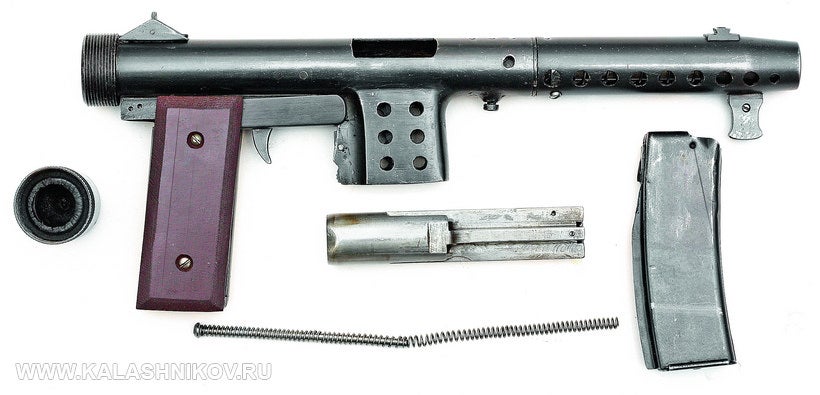
Field stripped KPPYa SMG
KPPYa is a simple blowback operated firearm firing from an open bolt. It is chambered in 7.62x25mm Tokarev and fed from 15-round detachable box magazines. The gun utilizes a fixed firing pin. The non-reciprocating charging handle is located on the front bottom portion of the barrel shroud. The reason Yazikov called his gun a Holster (or holster-style) SMG is because its holster was supposed to be attached to the bottom of the pistol grip and become a shoulder stock (see the top image of this article). The overall weight of the KPPYa SMG was 2.4 kilograms including the holster and ammunition (presumably with 15 rounds in one magazine).

Bottom view of the barrel shroud
One of the most interesting design features of this SMG is the pneumatic buffer/rate of fire reducer located on the rear portion of the receiver. This device consists of a set of alternating aluminum and rubber washers. The way it works is when the tail of the bolt enters the cavity created by the stack of washers, it seals that cavity and the air trapped into it can only escape through the small gaps presumably between the bolt and the stack of washers. This system was supposed to work as a pneumatic buffer slowing down the bolt, reducing the felt recoil and making the gun more controllable. This same device also was designed to work as a mechanism of reducing the rate of fire. Once the bolt reached its rearmost position, it was then pushed forward by the recoil spring creating sort of a temporary vacuum in the stack of washers which was relatively slowly filled by air sucked in through the same gaps that it was pushed out from. This delay lasting a fraction of a second was supposed to be enough to reduce the rate of fire.
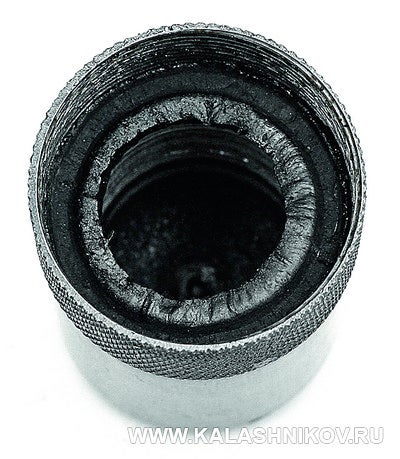
Buffer/rate reducer
This was the theory behind this system. However, that theory turned out not to be working at least for the first sample of the gun. The rate of fire reduction system completely failed. Not only it didn’t decrease the rate of fire but actually increased it to about 1200-1300 rpm. The problem was that the air couldn’t be completely removed from the buffer and it became a pneumatic spring throwing the bolt forward at a much higher speed than the recoil spring would accelerate it. Whether this was the primary reason or not, the project was ultimately halted. I assume if the buffer system was refined it could work as designed although that would probably be a system quite sensitive to the bullet weight, muzzle velocity and environmental temperature changes.
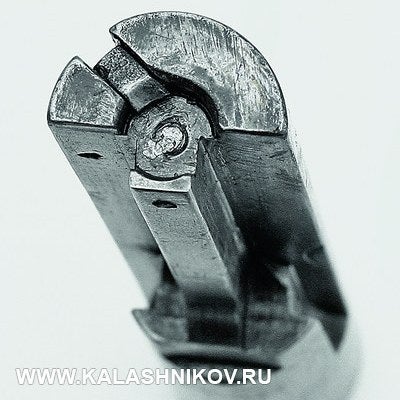
The bolt of the KPPYa SMG
This sample of Yazikov SMG is kept in the vault of Military Historical Museum of Artillery, Engineers and Signal Corps of Saint Petersburg.
Other Firearms of Foma Yazikov
Shortly after the SMG project failed, Yazikov was tasked to develop a mechanism of converting the M38 Mosin-Nagant carbine into a full auto weapon chambered in 7.62x25mm. The 7.62x54mmR and 7.62x25mm Tokarev have the same bullet diameter which allowed the designer to make a drop-in conversion unit similar to the Pedersen device. The new blowback bolt of the conversion kit also had a pneumatic buffer similar to that of the KPPYa SMG. This conversion carbine was fed from 25 and 50 round magazines.
According to the Kalashnikov Gun Magazine, in 1945 Yazikov has also developed a select fire carbine chambered in 7.62x54R. For some reason, these carbines were never produced and Yazikov gave his prototypes to the government and unfortunately, it is unknown what happened to these guns.
Besides the mentioned firearms, Yazikov had also designed a 16 gauge self-loading shotgun.
Unfortunately, we don’t know much about these firearms. In case if any information appears concerning these firearms, I’ll update this article.
Images from www.kalashnikov.ru
 Your Privacy Choices
Your Privacy Choices
